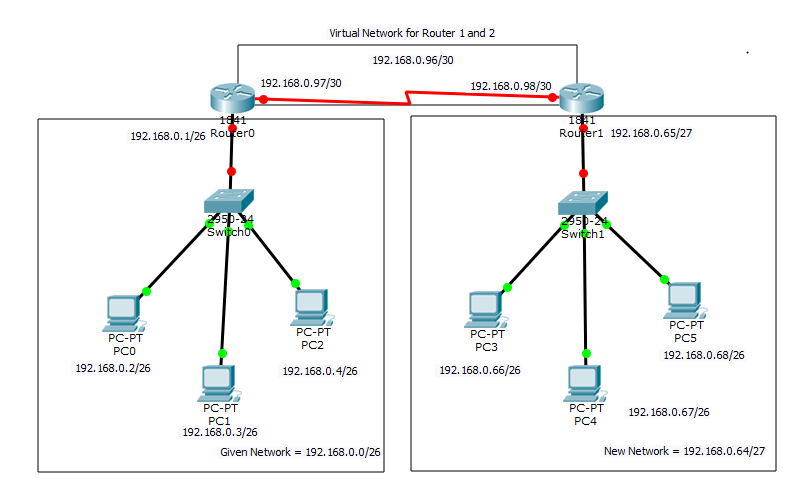Given Network = 192.168.0.0
Required hosts for Router 1 = 60
Required hosts for Router 2 = 30

Router 1 >= 60 hosts
60 <= 2n – 2
60 <= 26 – 2
60 <= 64 – 2
60 <= 62
Total number of network bits = 32
32 – n = 32 – 6 = 26 (CIDR of Router 1 network i.e. Given network)
i.e. 192.168.0.0/26
N.S.M = 11111111.11111111.11111111.11000000
= 255.255.255.192
Block Size = 256 – N.S.M
= 256 – 192 = 64
Note: Add this block size in given network so that we can get our new network for Router 2.
so the new network is 192.168.0.64/?
Now find FVH, LVH and Broadcast address
| Given Network | 192 | 168 | 0 | 0 |
| First Valid Host-FVH | 192 | 168 | 0 | 1 |
| Last Valid Host-LVH | 192 | 168 | 0 | 62 |
| Broadcast | 192 | 168 | 0 | 63 |
| New Network | 192 | 168 | 0 | 64 |
Router 2 >= 30 hosts
30 <= 2n – 2
30 <= 25 – 2
30 <= 32 – 2
30 <= 30
Total number of network bits = 32
32 – n = 32 – 5 = 27 (CIDR of Router 2 network i.e. New Network)
i.e. 192.168.0.64/27
N.S.M = 11111111.11111111.11111111.11100000
= 255.255.255.224
Block Size = 256 – N.S.M
= 256 – 224 = 32
Note: Add this block size in given network so that we can get our new network for Router 1 and 2 (Virtual Network).
so the new network is 192.168.0.96/?
Now find FVH, LVH and Broadcast address
| Given Network | 192 | 168 | 0 | 64 |
| First Valid Host-FVH | 192 | 168 | 0 | 65 |
| Last Valid Host-LVH | 192 | 168 | 0 | 94 |
| Broadcast | 192 | 168 | 0 | 95 |
| New Network | 192 | 168 | 0 | 96 |
Router 1 & 2 <= 2 hosts (we required only two IP to connect 2 routers)
2 <= 2n – 2
2 <= 22 – 2
2 <= 4 – 2
2 <= 2
Total number of network bits = 32
32 – n = 32 – 2 = 30 (CIDR of Virtual network (R1&R2)
i.e. 192.168.0.96/30
N.S.M = 11111111.11111111.11111111.11111100
= 255.255.255.252
Block Size = 256 – N.S.M
= 256 – 252 = 4
Note: Add this block size in given network so that we can get our new network for Router 3. This network can be used in future.
so the new network is 192.168.0.100/?
Now find FVH, LVH and Broadcast address
| Given Network | 192 | 168 | 0 | 96 |
| First Valid Host-FVH | 192 | 168 | 0 | 97 |
| Last Valid Host-LVH | 192 | 168 | 0 | 98 |
| Broadcast | 192 | 168 | 0 | 99 |
| New Network | 192 | 168 | 0 | 100 |

Basic Configuration on Router 1
— System Configuration Dialog —
Continue with configuration dialog? [yes/no]: no
Press RETURN to get started!
| Router>enable Router#configure terminal Router(config)#hostname R1 R1(config)#interface fastEthernet 0/0 R1(config-if)#ip address 192.168.0.1 255.255.255.192 R1(config-if)#no shutdown R1(config-if)#exit R1(config)#interface serial 0/0/0 R1(config-if)#ip address 192.168.0.97 255.255.255.252 R1(config-if)#clock rate 64000 R1(config-if)#no shutdown R1(config-if)#exit R1(config)#exit R1#write |
Basic Configuration on Router 2
— System Configuration Dialog —
Continue with configuration dialog? [yes/no]: no
Press RETURN to get started!
| Router>enable Router#configure terminal Router(config)#hostname R2 R2(config)#interface fastEthernet 0/0 R2(config-if)#ip address 192.168.0.65 255.255.255.224 R2(config-if)#no shutdown R2(config-if)#exit R2(config)#interface serial 0/1/0 R2(config-if)#ip address 192.168.0.98 255.255.255.252 R2(config-if)#no shutdown R2(config-if)#exit R2(config)#exit R2#write |
| Verification on Router 1 R1#show ip route C 192.168.0.0/26 is directly connected, FastEthernet0/0 C 192.168.0.96/30 is directly connected, Serial0/0/0 |
| Verification on Router 2 R2#show ip route C 192.168.0.64/27 is directly connected, FastEthernet0/0 C 192.168.0.96/30 is directly connected, Serial0/0/0 |



